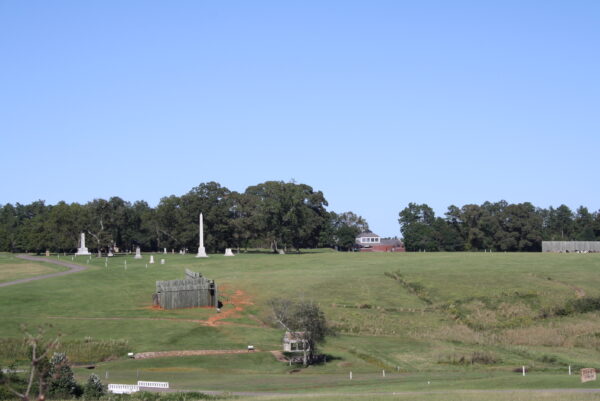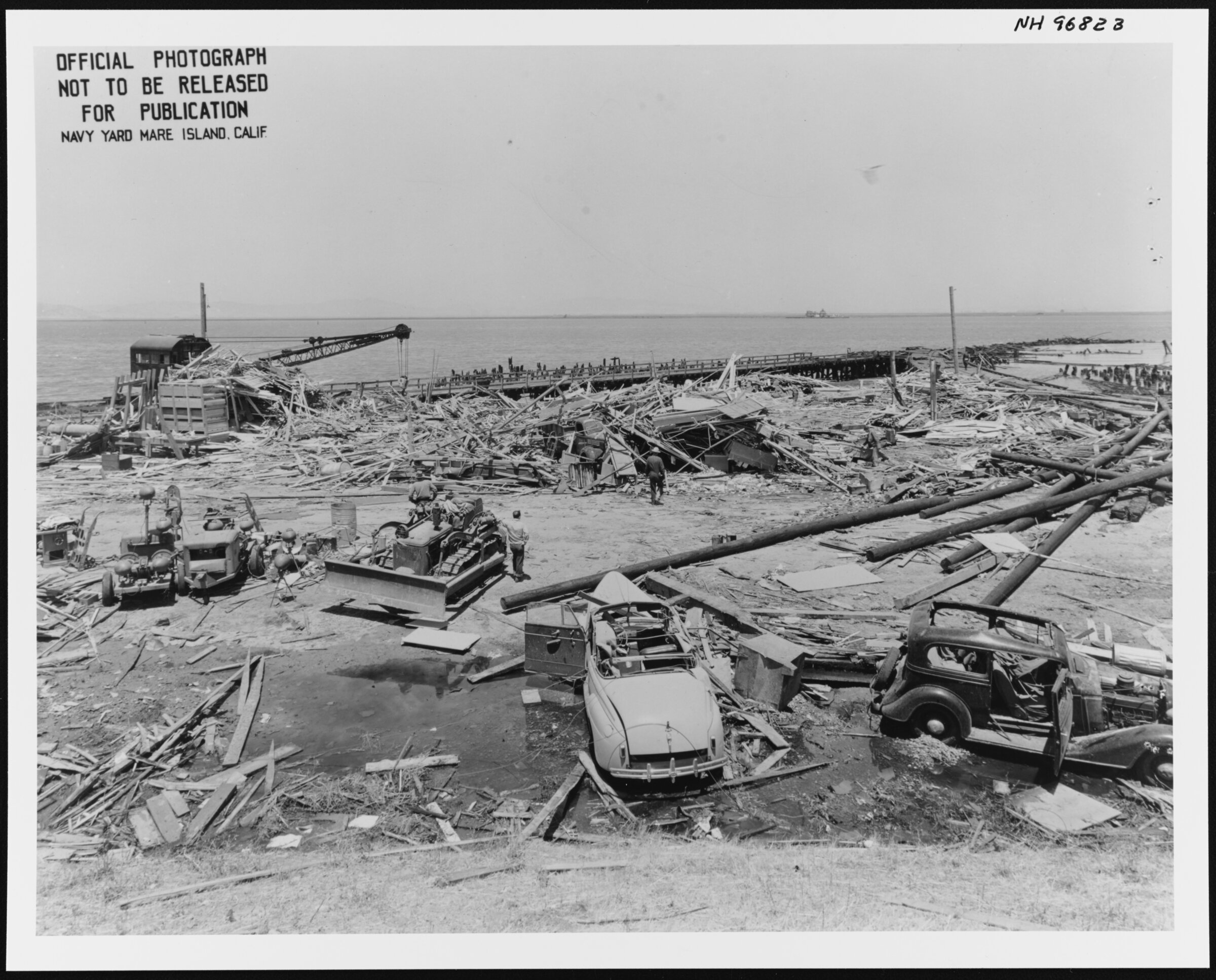Good news came the week after graduation ceremonies. I was offered a seasonal park ranger position at Georgia’s Andersonville National Historic Site, something that had been a dream of mine for years. Six months of working at a site that had featured heavily in my dissertation provided an opportunity to think about the challenges of presenting complicated history to public audiences.

When Andrew J. Riddle photographed the prison in 1864, more than 33,000 prisoners were held on 26 acres. Library of Congress.
The location of a massive prisoner-of-war camp during the US Civil War, Andersonville National Historic Site was something new to the National Park Service (NPS) when it was established in 1970—it didn’t offer a traditional narrative of military heroism. Georgia representative Jack Brinkley, sponsor of the bill that created the park, expressed the wish that historic sites serve “not to bolster the American ego, but to remind us that the way of life which we enjoy today was brought about by the often painful sacrifices of those who preceded us.” He argued that Andersonville should be a memorial to those throughout American history who “suffered the loneliness and anguish of captivity.” Like a time stamp, Brinkley’s language and bill marked a confluence of several late 20th-century impulses: renewed interest in the social history of the Civil War during and after the war’s centennial; fear that the bulldozer revolution would make it impossible for future generations to visit historic sites; and national mourning and anxiety over American prisoners in recent conflicts: World War II, Korea, and—as the bill passed through Congress—Vietnam.1
Andersonville promised not to be just another addition to a list of Civil War sites. The enabling legislation laid the groundwork for a three-pronged mission to emphasize the human cost of war. The park would interpret the nation’s deadliest Civil War site (including battlefields), where 13,000 prisoners of war died of disease and malnutrition. It would oversee the management of an active national cemetery. And, finally, the National Prisoner of War Museum would commemorate prisoners of war throughout American history. The park also had the possibility of being a national aberration: a place to talk about the human cost of war without romanticizing suffering. Andersonville’s antiwar potential had been recognized before. When Rhode Island governor Lucius Garvin dedicated a monument to his state at Andersonville in 1903, he focused not on North-South reconciliation, but rather world peace. His speech, entitled “Let Us Have Peace,” concluded, “Let every brave man’s death in this prison, let every monument here erected to his memory, be flagstones paving the way to universal peace. And may that road be short.”2 Some of that same sentiment was part of Andersonville’s establishment as a historic site in 1970.
Andersonville’s interpretive mission has evolved alongside political changes in the United States as well as changes in park leadership. Small parks experience cycles of high turnover in personnel, and most of Andersonville’s current programs were created by people who have since moved on from the site. Some of the programs, especially those designed for children, are exceptionally well crafted, even daring. Andersonville’s junior ranger program, influenced by a 2011 study by the Organization of American Historians (OAH) that criticized National Historic Sites’ timid interpretations, is modeled after a choose-your-own-adventure book that allows children to take on the role of a Civil War prisoner. The program balances historical structure and agency—in other words, those things within and outside a prisoner’s control. Although the park collects no demographic data on junior ranger visitors, a large proportion come from families traveling on Interstate 75 going to or coming from vacation in Florida.

Forty-five thousand US prisoners of war passed through the gate, reconstructed here, in 1864 and 1865. During the sesquicentennial, a Confederate flag flew on the hill in the background. Andersonville National Historic Site.
Junior rangers first must choose what to bring into the prison; on a subsequent page they learn what the guards confiscate. They then write a letter to loved ones and must choose how to get the letter out: by putting it in a mailbox? secreting it to an enslaved person? or giving it to a local white woman visiting the prison? Later, junior rangers face an even more personal dilemma. Their brother, a fellow prisoner, is sick. Junior rangers must choose between staying with their brother, attempting to escape with him, or escaping alone. Back at the desk at the end of the adventure, kids randomly select cards and learn whether they remained a prisoner until the end of the war, were paroled, successfully escaped, or died. As uncomfortable as I was at first explaining to seven-year-olds that they died in prison, I was struck by the recurring sober reaction. Children rarely cried or asked to redraw cards; most listened carefully as park rangers explained how their story ended, just like the 13,000 buried in the adjacent national cemetery. The bold program fosters historical empathy as it attempts to wring the romance out of war.
The National Prisoner of War Museum at Andersonville, designed and built in the late 1990s, also tries to have visitors see and hear through the eyes and ears of prisoners throughout US history. One of the museum’s central organizing principles, made clear in its interpretive plan and permanent exhibit, is the idea that captivity is a universal experience—that prisoners from the Vietnam War share similar physical and emotional experiences with those from the Revolutionary War. During my time at the site, I found it difficult to assess the museum’s effectiveness. Anecdotal comments by visitors to park staff indicate that the attitudes visitors bring with them into the museum shape the meaning they take out. In one of the more startling responses, an older, white man said that after seeing what the Japanese and Vietcong had done to US prisoners, he could not see what was wrong with waterboarding a few terrorists. Yet the more common response might simply be categorized as a pro-military sense of romanticized and necessary suffering. Whereas the junior ranger program exemplifies a bold interpretive strategy to challenge romanticized narratives of the Civil War, the diverse reactions to the museum’s permanent, transhistorical exhibition are reminders of the limitations of privileging emotional responses.

The prison site at Andersonville is adjacent to the National Prisoner of War Museum (shown in the background) and about one-third of a mile from the national cemetery (not shown). Andersonville National Historic Site.
The 2015 Charleston shooting and the national reaction to it intensified the challenge of mediating Andersonville’s history through formal interactions, such as ranger-led programs and informal contacts in the museum. After the Civil War, thousands of African Americans celebrated Dedication (Memorial) Day at Andersonville until barred from participating in the early 20th century. Based on my impressions, in 2015, the overwhelming majority of visitors were white. Adding to the complicated layers of racial history at this site, many white visitors complain today that the park dilutes history by not flying the Confederate flag. A Confederate flag had flown on a hill overlooking the prison site during the site’s 14-month sesquicentennial (2014–15) as a visual reminder of who was in charge when 13,000 US soldiers died there. As planned three years earlier, the flag came down in May 2015, but some visitors were convinced that taking it down was the result of national outcry over Confederate symbols. One visitor wrote on an unsealed survey card, “Taking down the flag because of the whining of a few n—–s is dumb!” On one occasion a convoy of a dozen trucks showed up waving Confederate flags. The flag question was a frequent reminder that visitors set the agenda as much as interpretive staff. Thus, the public shares interpretive authority with park staff, whether or not their agendas align.
As an early-career PhD and a seasonal park ranger, it was easier for me to identify problems than to develop realistic solutions. National parks such as Andersonville would benefit from employing more trained historians and public historians. In the OAH study, 51 percent of the permanent NPS employees working in history who responded reported no higher education in history or “some undergraduate courses.”3 For entry-level interpretation jobs with little decision-making authority, low education requirements in history, and often none in public history, mean that veterans without degrees often outrank nonveterans with bachelor’s degrees and higher. Yet the problem is not one-directional. While public history and museum programs train students for nonteaching careers better than traditional history educations, programs can always do more to make sure their graduates have the skills to navigate difficult histories and difficult audiences. Historical training alone is not enough to ensure effective interpretive strategies and make mediating tough interactions with visitors easier.
Reflective contemplation about the human cost of war is the dormant potential of Andersonville National Historic Site. The junior ranger program is an example of the type of bold interpretation that can happen for children and should happen for adult visitors. Yet opportunities to engage the public in a meaningful discussion about the cost of war are complicated by the reality that visitors influence how and what history gets discussed. If Andersonville can be a pathway to peace, it will be a bumpy one.
Notes
1. Benjamin Cloyd, Haunted by Atrocity: Civil War Prisons in American Memory (Baton Rouge: Louisiana State University Press, 2010), 166–67.
2. State of Rhode Island, Report of the Joint Special Committee on Erection of Monument at Andersonville, GA (Providence: E. L. Freeman & Sons, State Printers, 1903), 21.
3. Anne Mitchell Whisnant et al., Imperiled Promise: The State of History in the National Park Service (prepared for the Organization of American Historians, 2011), 13.
Evan A. Kutzler received an MA in public history and a PhD in US history from the University of South Carolina. Starting in August 2016, he will be an assistant professor of US and public history at Georgia Southwestern State University.
This work is licensed under a Creative Commons Attribution-NonCommercial-NoDerivatives 4.0 International License. Attribution must provide author name, article title, Perspectives on History, date of publication, and a link to this page. This license applies only to the article, not to text or images used here by permission.

